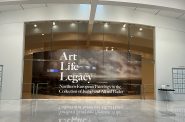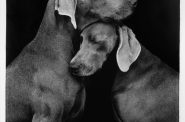Commercial but not crass
"Posters of Paris: Toulouse-Lautrec & His Contemporaries" opens Friday at the Milwaukee Art Museum.

Jules Chéret, (French, 1836–1932), L’Horloge: Les Girard, 1875/1878 or 1880/1881. Color lithograph. Collection of Jim and Sue Wiechmann. Photo by John R. Glembin.
Before you enter Posters of Paris: Toulouse-Lautrec & His Contemporaries at the Milwaukee Art Museum, observe the large title wall inside the expansive glass doors of the Baker/Rowland Galleries. This black-and-white 19th-century Parisian street scene, blown up massively from a tiny, grainy photograph, is more than window dressing. In the photo, a great many posters proclaim the wonders to be found in modern Paris. Our modern eyes see them through the charm and patina of time. The scene strikes our modern eyes as quaint. But it shows that even then, the Parisian public faced an onslaught of advertising.
The black-and-white prelude prepares our eyes for the vivacious color within. The exhibition, curated by Mary Weaver Chapin and augmented by a lavishly illustrated catalog, surveys the great wave of public advertising in the decadent Paris of the late 1800s. Such poster artists as Jules Chéret, lauded as the “Fragonard of the street,” captured this urban zeitgeist. Along with his lovely, anonymous and beguiling chérettes, he pictured singers, dancers and contortionists as if in still-frames in nightclub acts. Chéret hawks their entertainments to a public ready for fun. The poster artists were the carnival barkers, tempting with the pleasures of nightlife.
These big posters showed up in multiples on city walls, some in spaces reserved for advertisements. They also appeared on Morris columns, freestanding kiosks whose reason for existence was to hold up ads. You can still find these kiosks; look no further than Farwell and North Avenues, outside Hooligan’s Super Bar.
As Chapin noted, “We didn’t invent a thing.” Many modern modes of communication blossomed over a century ago, sans digital conveyance.

Henri de Toulouse_Lautrec (French, 1864–1901) Moulin Rouge—La Goulue, 1891 Color lithograph image: 75 x 45 3/4 in. (190.5 x 116.21 cm) sheet: 76 7/16 x 48 in. (194.15 x 121.92 cm) Milwaukee Art Museum, Gift of Mrs. Harry Lynde Bradley M1977.47 Photo by Larry Sanders
Toulouse-Lautrec stands at the center of this exhibition. This aristocrat worked in the language of the street. His uncanny eye and unerring fluency of line captured body and soul, however noble or decadent. His first poster, for the Moulin Rouge, combines the shadow play of spectators and the bawdy, dancing force of La Goulue (“The Glutton”). Her skirts and leg fly, giving quite a show for the assembled crowd. As spectators on the street, we’re drawn in.
These posters quickly took on life beyond the street. They became desirable objects and gained currency as a bona fide form of art as early as the 1880s, when affichomanie, or “poster mania,” took hold and posters gained credence as fine art. They appeared in specialized exhibitions, and dealers promoted them. Serious fine artists — Pierre Bonnard and Henri-Gabriel Ibels, for example — worked in the field.
Despite their pedigrees as street advertising, these posters beg to be appraised with the lingering absorption traditionally devoted to paintings. Spend some time with them. Get close. Notice the vibrancy of color, the cleverness of text, the subtlety of the printing process. Fine speckles of red ink read as tender flesh. A little more density conjures a freshly roughed cheek. And note shifting tastes and trends. Late in the French Poster Era, simplicity and directness prevail as the artists tried to reach a public speeding by in cars. The 20th-century was upon them.
How to adapt to the digital age in the 21st century? With an interesting debate, to be sure. Much advertising today is ephemeral, beamed through TV or computer screens, pixilated for display on giant digital billboards. Media is massive and far more transient than these gorgeous relics, which continue to captivate our contemporary imaginations.
Posters of Paris: Toulouse-Lautrec & His Contemporaries opens Friday, June 1, at the Milwaukee Art Museum and runs through Sept. 1.
Art
-
Exhibit Tells Story of Vietnam War Resistors in the Military
 Mar 29th, 2024 by Bill Christofferson
Mar 29th, 2024 by Bill Christofferson
-
See Art Museum’s New Exhibit, ‘Portrait of the Collector’
 Sep 28th, 2023 by Sophie Bolich
Sep 28th, 2023 by Sophie Bolich
-
100 Years Of Memorable Photography
 Sep 18th, 2023 by Rose Balistreri
Sep 18th, 2023 by Rose Balistreri
















